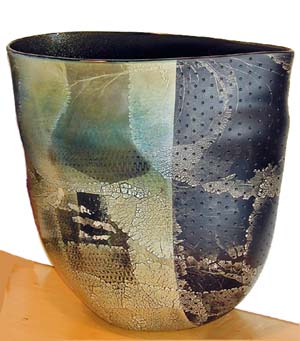 BRIAN HIRST |
|
 Brian Hirst, Teal Flat Form I, 2001, glass, gold and/or silver foil, 17 x 14 x 7 inches |
BRIAN
HIRST
"Silent Surface--Sacred Surface" January 19 through February 13, 2002 The exhibition includes eight new glass vessels with white gold or silver foil, and three wall panels. Hirst's golden bowls have a sculptural presence. They refer to the heroic shape of vessels and urns throughout the history of art, admired for their art and artistry. |
| Hirst's glass pieces embrace the artist's grounding in over 20 years of sculpture, print-making and glass blowing. His love of art history infuses his newest pieces in their shape, color and use of gold and silver. Religious art inspires Hirst's palette; the pure lapis blues of Chartres Cathedral windows, the gold of religious art. Ritual objects such as ceremonial shrine bowls of Japanese Buddhists, or the Tibetan singing bowl, inspire Hirst's forms. The silver and gold he uses in his new bowls comes from Japan and seems to carry the country's rich heritage in its depth of resonance. |  Brian Hirst, Copper Ruby Bowl Form, 2001, glass, gold and/or silver foil, 15 x 15 x 8 inches |
 Brian Hirst, White Gold Form, 2001 glass, silver and/or gold foil, 15 x 15 x 7 inches |
While his
earlier "flat form" vessels reference the figure in shape, using
a palette that speaks of nature and earth, his newest bowls are more boat-like
and suggest the sea in their blues, from cobalt to teal. In making his pieces,
Hirst pulls the bowls intentionally to one side, giving them an organic
quality, further suggesting a pouring jug or sailboat. Signature for Hirst is the design/motif on the front and back of each piece, an abstract image that for him is suggestive of abstract landscape. He includes a vertical rectangular field of lines or clouds of white traversing the rectangle, creating an abstracted minimalist landscape. |
| Brian Hirst
blows glass in the traditional Italian technique using precious metal foils.
He picks up the foils "hot" on the molten glass, creating a golden
interior to his "bowl forms" and leaves silvery foils on the outer
surface of each piece. When the vessel has cooled, he works back into the
foil and engraves the surface with graphic motifs, dots and patterns using
diamond burrs. For Hirst, the "surface" of his pieces is multi-layered with depths and textures. Each bowl invites the viewer to examine it up close to experience its fullness of hand and gesture. It is the subtleties of the surface that surround each bowl that contribute to the magic and ritual quality of this new body of work. |
|
 Brian Hirst, Japanese Silver Form, 2001, glass, gold and/or silver foil, 14 x 15 x 7 inches |
Hirst's wall
panels, which resonate the themes of his vessels, are created in a unique
way. They are drawings engraved onto black sheet glass that are painted
with platinum, gold-based luster and enamels. The glass panel is then fired
in a kiln at about 1,000 F. Like the bowls, the artist includes foils between
layers of paint to simulate the surfaces of the "bowl forms."
As the exhibition title suggests, it is the silence of the surface, the invitation to draw the viewer into the work that produces a soulful and sacred moment. Brian Hirst was born in Gippsland, Victoria, Australia, in 1956. He received a Diploma of Arts from Monash University, Gippsland Campus. He also attended Sydney College of Arts and was Senior Lecturer at the Canberra School of Art. He has received international acclaim over the years, including winning the prestigious "World Glass Now 94" prize from the Hokkaido Museum of Modern Art. |
| He has shown
at the Art Gallery of Western Australia, Perth; The Azabu Museum of Arts
and Crafts, Tokyo; Galerie L. Standtisches Museum and Glasmuseum, Reinbach,
Germany; Heisslsches Landmuseum, Darmstadt, Germany; Hokkaido Museum of
Modern Art, Japan; Lemberk Castle, Czech Republic; National Gallery of Victoria,
Melbourne; National Museum of Modern Art, Tokyo; and Queensland Art Gallery. The artist's work can be found in the collections of the Art Gallery of Western Australia, Perth; Australian National Gallery, Canberra; The Australian National University, Canberra; Corning Museum of Glass, New York; Ebeltoft Glasmuseum, Denmark; Fine Arts Museum of San Francisco; Gippsland Regional Art Gallery, Victoria; Glasmuseum, Hentrich, Germany; Guang Don Province, China; Hokkaido Museum of Modern Art, Japan; Koganazaki Glass Museum, Japan; Kunstmuseum, Dusseldorf, Germany; Musee de Verre, Sans Poteries, France; Museum of Applied Arts & Sciences, Sydney; Museum of Modern Art, Kyoto, Japan; National Gallery of Victoria, Melbourne; Queensland Art Gallery, Brisbane; Victorian State Craft Collection, Melbourne; Wagga Wagga City Art Gallery, New South Wales; and Yokohama Museum, Japan. |
 Brian Hirst, Teal Flat Form, 2001, glass, gold and/or silver foil, 20 x 16 x 6 inches |